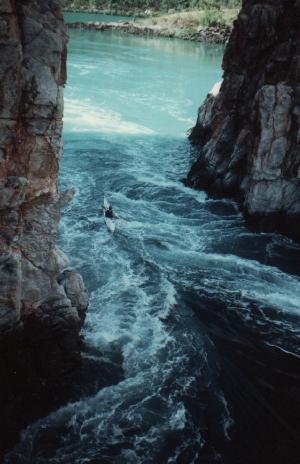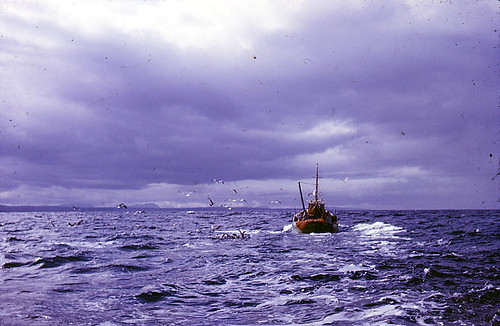Tuckey's Tidal Dreaming
Posted by Big Gav on November 6, 2008 - 7:59am in The Oil Drum: Australia/New Zealand
The ABC has a report today noting that Wilson "Ironbar" Tuckey is still promoting his vision of large scale tidal power generation in the Kimberly region in Western Australia.
The Federal Government expected to release their white paper on Australia's future energy needs next year and the use of tidal power in the Kimberley is expected to be one of the options under consideration.
There are renewed calls for the development of renewable energy in the Kimberley, with the federal Member for O'Connor spruiking the merits of tidal power. Wilson Tuckey wants the Commonwealth to spend $10 billion establishing the necessary infrastructure for a tidal power industry in the region.
Mr Tuckey says tidal energy could provide 10 times the country's current electrical capacity without producing any carbon emissions. He says the Commonwealth should fund start up infrastructure before commercial interests jump on board like the State Government did with the North West Shelf. "This will be the same. If the Australian Government puts in the original tidal generating capacity and the interconnecting transmission lines, which is probably the most important, the Kimberley will then see a rash of people charging in to produce that same electricity from other localities," he said.
There hasn't been any commercial tidal power development in Australia thus far (although experiments are underway in Tasmania), but the Kimberly region has long been a target for would be developers of tidal power projects for many years, due to its enormous potential (a tidal range of 11 metres).
 Thus far all of the proposed projects have been stymied by the remoteness of the location from the Western Australian and national electricity grids and by environmental concerns. A number of possible sites have been identified, including Secure Bay, Walcott Inlet, George Water and St. George's Basin.
Thus far all of the proposed projects have been stymied by the remoteness of the location from the Western Australian and national electricity grids and by environmental concerns. A number of possible sites have been identified, including Secure Bay, Walcott Inlet, George Water and St. George's Basin.
Tuckey has long been the most vocal supporter of a Kimberly tidal project, pointing out if a link was built to the eastern states grid (thus creating a truly national power grid) it would obviate the need for any consideration of nuclear power. Some Kimberly tidal power advocates have also tried to base the idea of a "hydrogen economy" on the resource, though this seems a lot more far-fetched than a grid link.
A link to the grid could also potentially include large scale CSP solar in the western australian deserts, which are one of the best solar resources in the world, along with geothermal power in central Australia and perhaps coal seam gas developments in Queensland.
It is far from clear that Kimberly tidal would be economically competitive with solar thermal plants in the desert, but it will be interesting to see if the upcoming government report explores the concept, including financials, in any depth. Mixing large scale tidal power from the north, solar and geothermal from the centre, biogas and biomass from the east and wind and waves from the south would provide the sort of geographical and source diversity required to run a national grid powered completely by clean energy sources - which is a leap the nation will need to make in the coming years.
Looking across the ditch, there is an attempt to create a tidal power pilot project in the Cook Strait.
A project to generate power from tidal turbines in Cook Strait expects to have a pilot programme underway by 2011. Christchurch scientists David Beach and Chris Bathurst are applying for Government funding this month and also hope to secure private investor funds to enable a turbine to be built and placed 90m deep off Sinclair Head on Wellington's south coast. ... Cook Strait was one of the most exceptional sources of tidal energy in the world because of the depth and width of the waterway, Mr Beach said. The 23km wide channel reaches 250m at its deepest.
And up in the UK, interest in tidal power continues to grow, with the BBC reporting on a new survey of tidal power sites.
A survey of the potential of the Pentland Firth and the sea around the Orkney islands to generate energy from tidal devices is to be carried out. Development agency Highlands and Islands Enterprise (HIE) is funding the work by Stromness-based company Aquatera. HIE said the results would fill gaps in what was already known about the areas.
The Pentland Firth is the first UK marine site to be opened up for commercial-scale development. The Crown Estate has invited applications from developers to run marine energy projects in the firth. HIE confirmed last month it had carried out discussions with tidal power developer Atlantis Resources Corporation about a proposed computer data centre in Caithness supplied by renewable energy.

Cross-posted from Peak Energy.




Presumably the Western Australia idea is for a barrage like in the Rance scheme in France? I believe that the Cook Strait idea is to capture the tidal current because in NZ the tidal ranges are too low.
I think they should have a look at the Kimberley idea but I doubt it is economic compared with abundant Gas in WA given the limited vision of most governments. The UK has not pursued anything with the river Severn even though their energy resources are much more sparse than Australia's.
Well - the UK govt is considering a range of plans for developing the Severn right now, so I wouldn't say they have given up on the idea - they are just very slow moving.
Some of the best sites in the Kimberly (like the one pictured) are narrow, fjord like formations - you are right that presumably they would have some sort of barrage built across them.
Tidal turbines could also be used I guess, but they wouldn't generate as much power.
Nice post Gav,
The tide pattern around NZ is amazing - if it's high tide on one side of the islands it's low tide on the other, and Cook Strait conveniently connects the two!
A fascinating animation here:
http://www.teara.govt.nz/EarthSeaAndSky/OceanStudyAndConservation/OceanC...
Tidal power for all of Australia! Just how many gigawatts are we talking about here?
its not a barrage system because of the problems of siltration - it is a tidal fence - all the information is on www.wilsontuckey.com.au - the proposal is for a HVDC grid which is a system now in use around the world which has greater carrying capacity over longer distances without the same drop off as AC systems - the tidal document on Wilson's website address all these issues.
Alana Lacy
Office Manager
HON WILSON TUCKEY MP
Thanks Alana - I didn't think to look at Wilson's web site.
I'm glad a tidal fence is what is being proposed - and hopefully at some point a HVDC link between the north west and the rest of the country will be constructed.
For those interested in more, the plan is here (PDF) :
http://www.wilsontuckey.com.au/news/pdf/Newsletter%20-%20Securing%20Aust...
Thanks from me also.
It looks like a good idea not having the generators submerged by having that 'fence' arrangement with them on top. That will save lots of trouble because everyone knows that electricity and water 'don't mix' very well. From your figures given on the press relase it looks like you will be getting a capacity factor of around 25% which is comparable with wind. Also the Secure Bay option appears to have an inlet that is only 1km in width so will save money on the number of generators.
And not having a barrage saves in engineering problems such as those during the closing of the Zuider Zee dike below.